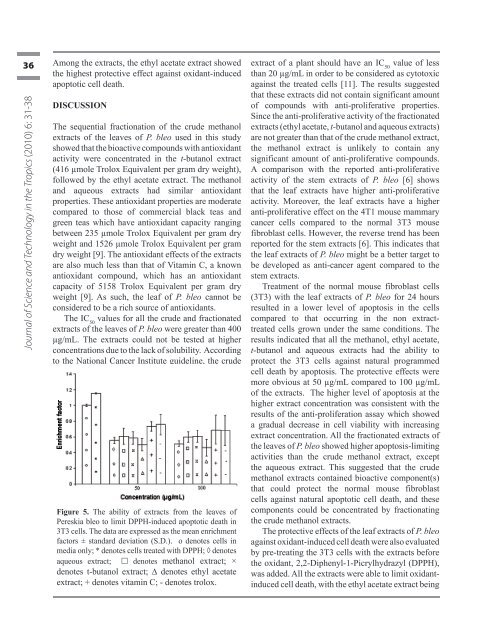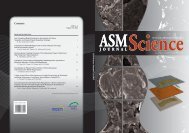Download - Akademi Sains Malaysia
Download - Akademi Sains Malaysia
Download - Akademi Sains Malaysia
You also want an ePaper? Increase the reach of your titles
YUMPU automatically turns print PDFs into web optimized ePapers that Google loves.
36<br />
Journal of Science and Technology in the Tropics (2010) 6: 31-38<br />
Among the extracts, the ethyl acetate extract showed<br />
the highest protective effect against oxidant-induced<br />
apoptotic cell death.<br />
DISCUSSION<br />
The sequential fractionation of the crude methanol<br />
extracts of the leaves of P. bleo used in this study<br />
showed that the bioactive compounds with antioxidant<br />
activity were concentrated in the t-butanol extract<br />
(416 µmole Trolox Equivalent per gram dry weight),<br />
followed by the ethyl acetate extract. The methanol<br />
and aqueous extracts had similar antioxidant<br />
properties. These antioxidant properties are moderate<br />
compared to those of commercial black teas and<br />
green teas which have antioxidant capacity ranging<br />
between 235 µmole Trolox Equivalent per gram dry<br />
weight and 1526 µmole Trolox Equivalent per gram<br />
dry weight [9]. The antioxidant effects of the extracts<br />
are also much less than that of Vitamin C, a known<br />
antioxidant compound, which has an antioxidant<br />
capacity of 5158 Trolox Equivalent per gram dry<br />
weight [9]. As such, the leaf of P. bleo cannot be<br />
considered to be a rich source of antioxidants.<br />
The IC 50 values for all the crude and fractionated<br />
extracts of the leaves of P. bleo were greater than 400<br />
µg/mL. The extracts could not be tested at higher<br />
concentrations due to the lack of solubility. According<br />
to the National Cancer Institute guideline, the crude<br />
Figure 5. The ability of extracts from the leaves of<br />
Pereskia bleo to limit DPPH-induced apoptotic death in<br />
3T3 cells. The data are expressed as the mean enrichment<br />
factors ± standard deviation (S.D.). o denotes cells in<br />
media only; * denotes cells treated with DPPH; ◊ denotes<br />
aqueous extract; denotes methanol extract; ×<br />
denotes t-butanol extract; Δ denotes ethyl acetate<br />
extract; + denotes vitamin C; - denotes trolox.<br />
extract of a plant should have an IC 50 value of less<br />
than 20 µg/mL in order to be considered as cytotoxic<br />
against the treated cells [11]. The results suggested<br />
that these extracts did not contain significant amount<br />
of compounds with anti-proliferative properties.<br />
Since the anti-proliferative activity of the fractionated<br />
extracts (ethyl acetate, t-butanol and aqueous extracts)<br />
are not greater than that of the crude methanol extract,<br />
the methanol extract is unlikely to contain any<br />
significant amount of anti-proliferative compounds.<br />
A comparison with the reported anti-proliferative<br />
activity of the stem extracts of P. bleo [6] shows<br />
that the leaf extracts have higher anti-proliferative<br />
activity. Moreover, the leaf extracts have a higher<br />
anti-proliferative effect on the 4T1 mouse mammary<br />
cancer cells compared to the normal 3T3 mouse<br />
fibroblast cells. However, the reverse trend has been<br />
reported for the stem extracts [6]. This indicates that<br />
the leaf extracts of P. bleo might be a better target to<br />
be developed as anti-cancer agent compared to the<br />
stem extracts.<br />
Treatment of the normal mouse fibroblast cells<br />
(3T3) with the leaf extracts of P. bleo for 24 hours<br />
resulted in a lower level of apoptosis in the cells<br />
compared to that occurring in the non extracttreated<br />
cells grown under the same conditions. The<br />
results indicated that all the methanol, ethyl acetate,<br />
t-butanol and aqueous extracts had the ability to<br />
protect the 3T3 cells against natural programmed<br />
cell death by apoptosis. The protective effects were<br />
more obvious at 50 µg/mL compared to 100 µg/mL<br />
of the extracts. The higher level of apoptosis at the<br />
higher extract concentration was consistent with the<br />
results of the anti-proliferation assay which showed<br />
a gradual decrease in cell viability with increasing<br />
extract concentration. All the fractionated extracts of<br />
the leaves of P. bleo showed higher apoptosis-limiting<br />
activities than the crude methanol extract, except<br />
the aqueous extract. This suggested that the crude<br />
methanol extracts contained bioactive component(s)<br />
that could protect the normal mouse fibroblast<br />
cells against natural apoptotic cell death, and these<br />
components could be concentrated by fractionating<br />
the crude methanol extracts.<br />
The protective effects of the leaf extracts of P. bleo<br />
against oxidant-induced cell death were also evaluated<br />
by pre-treating the 3T3 cells with the extracts before<br />
the oxidant, 2,2-Diphenyl-1-Picrylhydrazyl (DPPH),<br />
was added. All the extracts were able to limit oxidantinduced<br />
cell death, with the ethyl acetate extract being<br />
Jostt vol 6.indd 36 7/22/10 10:09:17 PM

















